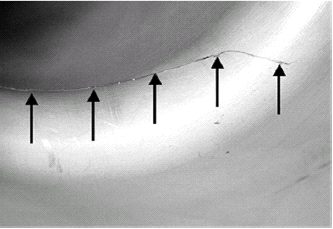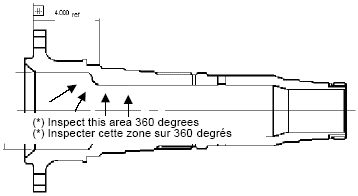AL 2005-05
18 March 2005
PW100 Series Engines Propeller Shaft Cracking
Transport Canada was notified of a recent PW100 propeller shaft found with a through-going crack (See Figure 1) at the No.19 bearing area. This is the second propeller shaft identified with this defect. The root cause was positively identified as "Hydrogen Embrittlement" caused by the nickel-plating repair process performed at an overhaul facility. These two exceptional events are related to the excessive period of time that the propeller shaft spent in the nickel-plating tank.
Both events were discovered following a persistent external oil leak in the propeller shaft area, as the crack had migrated past the seal runner. Pratt & Whitney Canada (P&WC) is currently working on revisions to the engine maintenance manuals (EMM) to include a visual inspection to be carried out inside the propeller shaft as shown in Figure 2. This inspection will be recommended when the propeller is removed at engine change or for plain seal replacement due to persistent oil leakage. Please refer to the appendix A for the list of EMM Temporary Revisions applicable to each engine model.
In an effort to reduce the possibility of "Hydrogen Embrittlement", a series of cautions have been published to the P&WC Repair Facilities Network, including the Designated Overhaul Facilities and Distributor Designated Overhaul Facilities for all the propeller shaft nickel plate repairs. P&WC Service Bulletin 21713 was published on 20 December 2004 to recommend propeller shaft non-destructive test inspection be performed the first time the engine or module is at a shop capable to perform the procedures.
In addition, P&WC Service Bulletin 21714 will be published to identify all suspected propeller shafts in service, which need to be inspected until replacement.
Transport Canada will issue an airworthiness directive to deal with known suspect propeller shafts as they are identified. However, as there are many engine repair and overhaul shops worldwide, identifying all suspect propeller shafts is a challenge, therefore, Transport Canada strongly recommends operators to complete the following:
- Advise their maintenance and flight crews to report any oil leaks resulting in streaking, pooling or puddling of oil, especially in around the gear box and propeller shaft area of the engines:
- If the oil leak is minor, operations may continue until a maintenance base capable of inspecting the propeller shaft seal area for leaks is reached; and
- If the oil leak is heavy, remove the propeller as soon as possible to permit an internal inspection as per the engine maintenance manual;
- Perform a propeller shaft non-destructive test inspection the first time the engine or module is at a shop capable to perform the procedures as per P&WC SB 21713; and
- Report any further defects or occurrences via the Service Difficulty Reporting program.
Figure 1 - Propeller shaft crack
Figure 2 - Propeller shaft crack location (*)
Figure 3 - List of Engine Maintenance Manual Temporary (TR) Revisions
PW118/A/B: 72-130, 131, 132, 133
PW119B/119C: T.B.D.
PW120/121/121: 72-108, 109, 110, 111
PW121/120A: 72-120, 121, 122, 123
PW123/B/C/D/E: 72-83, 84, 85, 86
PW123AF: 72-54, 55, 56, 57
PW124B/127/E/F: 72-89, 90, 91, 92
PW125B/127B: 72-94, 95, 96, 97
PW126/A/127D: 72-100, 101, 102, 103
PW127G: 72-8, 9, 10, 11
PW127H: 72-8, 9, 10, 11
PW127C/J: 72-5, 6, 7, 8
For further information contact a Transport Canada Centre, or call Mr. Luc Deniger, Continuing Airworthiness, Ottawa, telephone 613 952-5385, facsimile 613 996-9178 or e-mail denigel@tc.gc.ca.
For Director, National Aircraft Certification
B. Goyaniuk
Chief, Continuing Airworthiness
Note: For the electronic version of this document, please consult the following Web address: https://tc.canada.ca/en/aviation/aircraft-airworthiness/aircraft-certification

